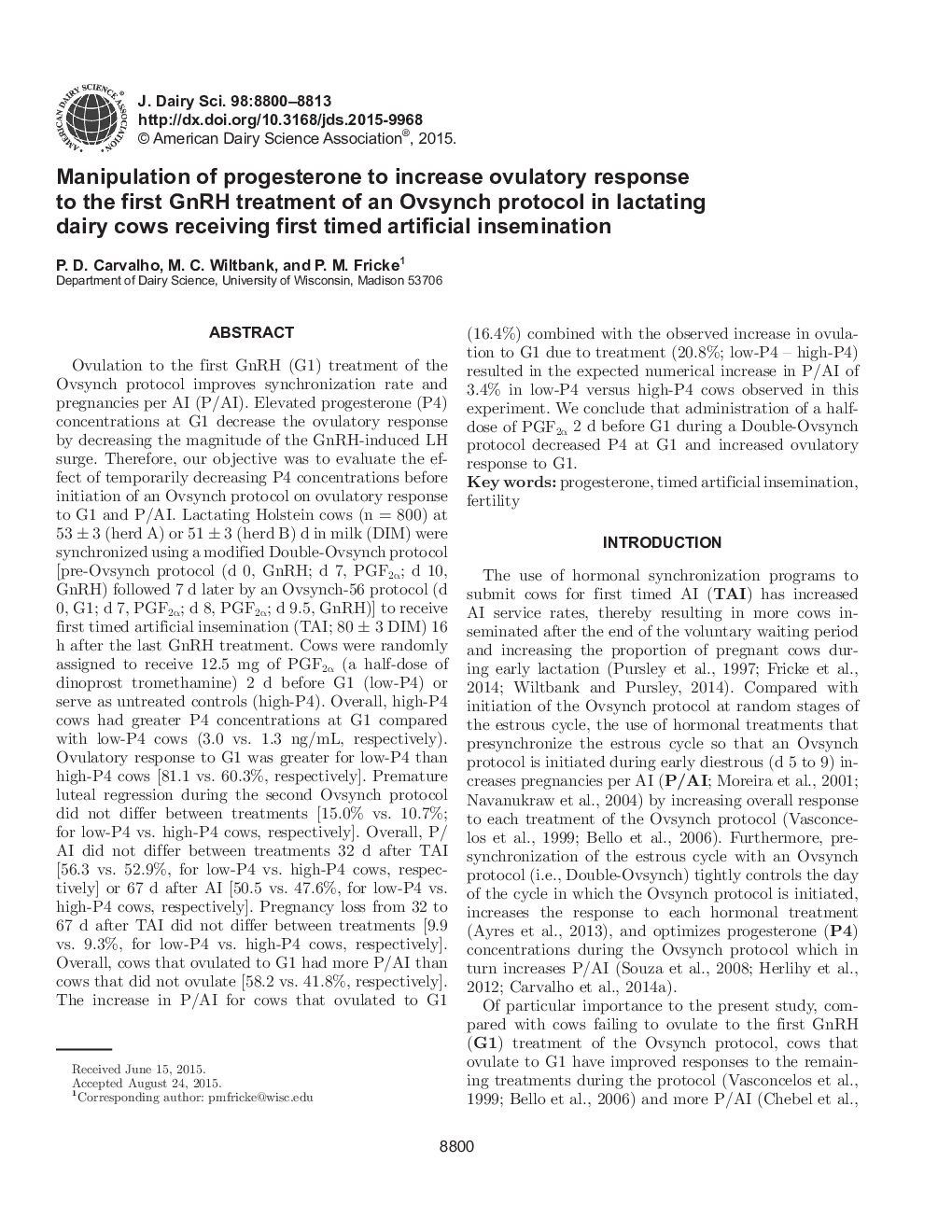| کد مقاله | کد نشریه | سال انتشار | مقاله انگلیسی | نسخه تمام متن |
|---|---|---|---|---|
| 10973416 | 1108014 | 2015 | 14 صفحه PDF | دانلود رایگان |
عنوان انگلیسی مقاله ISI
Manipulation of progesterone to increase ovulatory response to the first GnRH treatment of an Ovsynch protocol in lactating dairy cows receiving first timed artificial insemination
دانلود مقاله + سفارش ترجمه
دانلود مقاله ISI انگلیسی
رایگان برای ایرانیان
کلمات کلیدی
موضوعات مرتبط
علوم زیستی و بیوفناوری
علوم کشاورزی و بیولوژیک
علوم دامی و جانورشناسی
پیش نمایش صفحه اول مقاله

چکیده انگلیسی
Ovulation to the first GnRH (G1) treatment of the Ovsynch protocol improves synchronization rate and pregnancies per AI (P/AI). Elevated progesterone (P4) concentrations at G1 decrease the ovulatory response by decreasing the magnitude of the GnRH-induced LH surge. Therefore, our objective was to evaluate the effect of temporarily decreasing P4 concentrations before initiation of an Ovsynch protocol on ovulatory response to G1 and P/AI. Lactating Holstein cows (n = 800) at 53 ± 3 (herd A) or 51 ± 3 (herd B) d in milk (DIM) were synchronized using a modified Double-Ovsynch protocol [pre-Ovsynch protocol (d 0, GnRH; d 7, PGF2α; d 10, GnRH) followed 7 d later by an Ovsynch-56 protocol (d 0, G1; d 7, PGF2α; d 8, PGF2α; d 9.5, GnRH)] to receive first timed artificial insemination (TAI; 80 ± 3 DIM) 16 h after the last GnRH treatment. Cows were randomly assigned to receive 12.5 mg of PGF2α (a half-dose of dinoprost tromethamine) 2 d before G1 (low-P4) or serve as untreated controls (high-P4). Overall, high-P4 cows had greater P4 concentrations at G1 compared with low-P4 cows (3.0 vs. 1.3 ng/mL, respectively). Ovulatory response to G1 was greater for low-P4 than high-P4 cows [81.1 vs. 60.3%, respectively]. Premature luteal regression during the second Ovsynch protocol did not differ between treatments [15.0% vs. 10.7%; for low-P4 vs. high-P4 cows, respectively]. Overall, P/AI did not differ between treatments 32 d after TAI [56.3 vs. 52.9%, for low-P4 vs. high-P4 cows, respectively] or 67 d after AI [50.5 vs. 47.6%, for low-P4 vs. high-P4 cows, respectively]. Pregnancy loss from 32 to 67 d after TAI did not differ between treatments [9.9 vs. 9.3%, for low-P4 vs. high-P4 cows, respectively]. Overall, cows that ovulated to G1 had more P/AI than cows that did not ovulate [58.2 vs. 41.8%, respectively]. The increase in P/AI for cows that ovulated to G1 (16.4%) combined with the observed increase in ovulation to G1 due to treatment (20.8%; low-P4 - high-P4) resulted in the expected numerical increase in P/AI of 3.4% in low-P4 versus high-P4 cows observed in this experiment. We conclude that administration of a half-dose of PGF2α 2 d before G1 during a Double-Ovsynch protocol decreased P4 at G1 and increased ovulatory response to G1.
ناشر
Database: Elsevier - ScienceDirect (ساینس دایرکت)
Journal: Journal of Dairy Science - Volume 98, Issue 12, December 2015, Pages 8800-8813
Journal: Journal of Dairy Science - Volume 98, Issue 12, December 2015, Pages 8800-8813
نویسندگان
P.D. Carvalho, M.C. Wiltbank, P.M. Fricke,